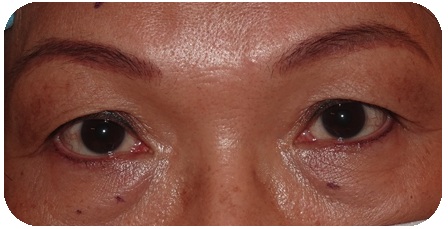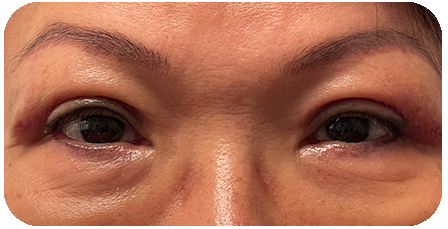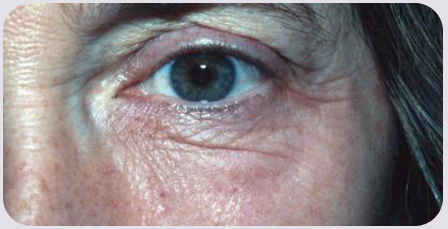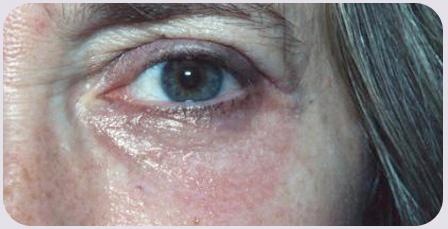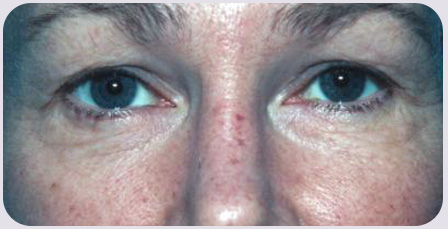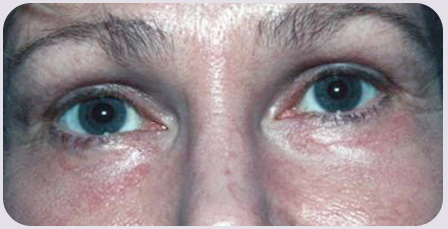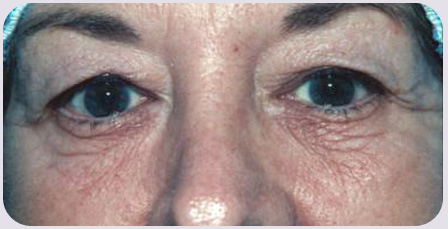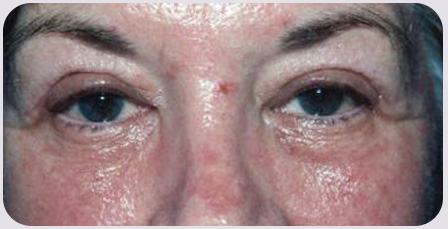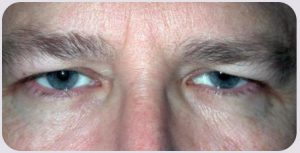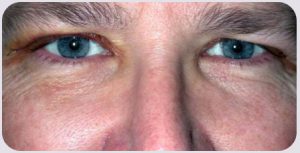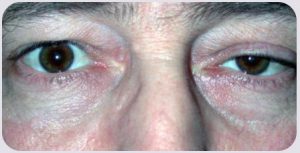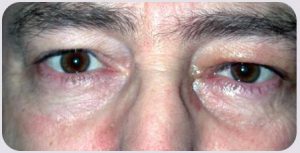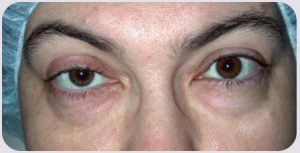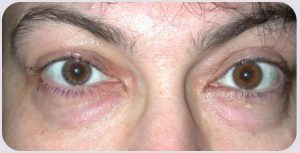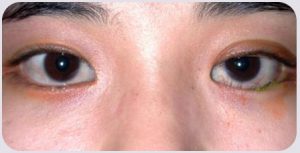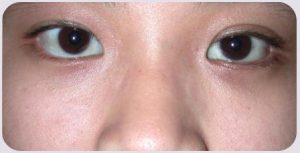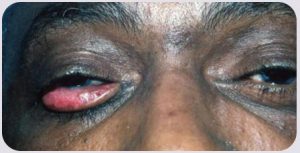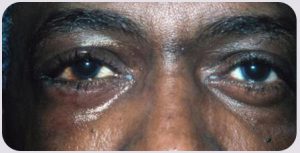QUESTIONS FOR THE DOCTOR
EYELID SURGERY
What can I expect when I have eyelid surgery?
Surgery is performed in a private outpatient surgery center. Most procedures are performed under a local anesthetic with light sedation. Recovery is dependent upon the procedure. However, one generally has light bruising and swelling for one week to two weeks. Patients can drive the next day and perform their usual activities except heavy lifting or strenuous exercise for one week. If an individual has surgery on both eye lids, the eyes are not patched after surgery. If surgery is performed on one eyelid, on occasion, and only for certain procedures, one eye may be patched for a day. It is important to use ice compresses for the first 48 hours. Switch to warm compresses after the first 48 hours and continue use until the swelling subsides. The warm compresses dilate blood vessels and help to reduce swelling and clear bruises.
Are there any medications to avoid prior to surgery?
It is very important to avoid aspirin and nonsteroidal anti-inflammatory drugs (e.g., Aleve, Motrin, Advil, etc.) for two weeks prior to surgery. These medications interfere with platelet function and can prevent clotting during surgery. If you are taking blood thinners such as Coumadin (Warfarin), Eliquis or Plavix, it is important to check with your primary care physician or cardiologist prior to discontinuing use of these medications.
How long will I benefit from the results of an eyelid lift?
An eyelid lift (blepharoplasty) is generally performed once. Occasionally an individual may undergo a touchup as they age. Although the skin and fat around the eyes does not grow back once removed, the surgery does not immunize one from aging. As such the eyelid skin can continue to lose some elasticity, the brow can descend and the fat behind the eyes move forward.
I am contemplating losing weight-should I delay eyelid surgery?
The fat around ones eyes is not weight dependent. Therefore, though it is admirable to lose weight if needed, this should not interfere with the decision to undergo eyelid surgery.
BLEPHAROPLASTY
What is Blepharoplasty?
Blepharoplasty is one of the most common procedures performed by an oculoplastic surgeon. This is an outpatient surgery which can “lift” the heaviness from the upper lid and reduce the fullness of the lower lid. The procedure can be combined with laser resurfacing to diminish crow’s feet as well. Surgery can be performed for cosmetic reasons to achieve a natural, more youthful appearance. Occasionally, the upper lid surgery is performed to increase the field of vision in an individual whose heavy lids diminish their vision.
What is Asian Blepharoplasty?
Asian blepharoplasty is a procedure in which an individual with a single lid fold configuration is provided with a double lid fold or crease. It is known that approximately half of the Asian population has a single lid fold and half of the Asian population has a double lid fold. Those with a single fold may wish to have a double crease formed to allow for a more open-eyed look.
LASER RESURFACING
I am concerned about the wrinkles around my eyes, should I undergo blepharoplasty or laser resurfacing?
Laser resurfacing is the treatment of choice for static wrinkles or wrinkles at rest. Botox is the treatment of choice for dynamic wrinkles or wrinkles associated with the movement of facial expression. Eyelid surgery, though useful for loose skin or extra fullness, does not, for the most part, unwrinkle wrinkles.
How does the laser reduce wrinkling?
The CO2 or other types of lasers vaporize the superficial layer of the skin in a complete or fractionated (polka dot) like fashion. In the process of healing, the body lays down a new skin with organized collagen. This new skin is smoother and fresher in appearance.
Who is a candidate for laser resurfacing?
Though laser resurfacing has been used on patients of all skin types, the patients that respond most easily are fair toned individuals with age and sun related changes. Patients with darker tones may need to undergo pretreatment with creams to turn off the production of melanin prior to starting treatment. Additionally, these individuals should consider a preoperative skin test to gauge healing.
THERMAGE
What is Thermage?
Thermage or Thermacool is a new noninvasive technique that uses radiofrequency technology to deliver heat to the deeper layers of the skin while cooling the surface layers. This allows for the contracture of the collagen in the skin and promotes the deposition of new collagen. Over time, as the collagen is deposited, patients report that their skin feels thicker and appears more youthful.
Thermage is an outpatient procedure, performed with the aid of a local anesthetic. It does not produce the same degree of correction as can be achieved with either surgery or a CO2 resurfacing. However, in most cases, it is a useful, minimally invasive technique with no significant downtime.
IPL
What is IPL?
IPL or intense pulsed light is a technique which uses light energy to treat facial redness, lighten areas of hyper-pigmentation (brown discoloration) and stimulate collagen deposition. This is a noninvasive treatment that may require several sessions, however there is typically no down time and patients may return to work and their normal activities following treatment.
MICRODERMABRASION
What is microdermabrasion?
Microdermabrasion is a technique in which crystals are used to abrade the superficial layers of the skin providing for a deep cleansing of the pores, softening of fine lines and a fresh look. There is typically no down time associated with this technique.
BOTOX AND DYSPORT
What is Botox and Dysport?
Botox and Dysport are the trade names for Botulinum toxin Type A. This is an FDA approved drug used to treat dynamic wrinkles or wrinkles with movement. Botox has been used for over 20 years to treat some aspects of facial spasm (blepharospasm and hemifacial spasm) and crossed eyes. It was approved in 2001 for the treatment of wrinkles. It is especially useful for treating wrinkles of the forehead and the area between the brows. It can also be used to treat crow’s feet, “lipstick” lines as well as platysmal or neck bands.
Dysport received FDA approval in 2009 for the treatment of glabellar wrinkles (the furrows between the brows). It has the same mechanism of action as Botox. Its effects may both take place and wear off a bit more quickly than Botox.
Botox or Dysport is injected directly into the muscles. Botox or Dysport weakens or partially paralyzes the muscles so that the muscle’s ability to squeeze is diminished. As a result, wrinkles are softer or eliminated. The medication lasts 3-4 months and can be repeated when the effect wears off.
There are no known systemic side effects of these drugs in the doses that are typically used for medical and cosmetic indications. On occasion, one may develop a droopy eyelid if the Botox or Dysport is injected too closely to the eyelid. If necessary, this can be treated with eye drops.
In general, Botox and Dysport treatments have proven to be extremely effective methods of reducing dynamic wrinkles that result from habitual facial expressions. They are not effective treatments for wrinkles at rest, deep folds or wrinkles that are the result of severe skin damage due to sun exposure.
The doses used for Botox and Dysport are quite different and not interchangeable. It is important that care be taken to provide the appropriate dose when using these medications.
FILLERS
What are fillers?
Fillers are materials that are used to replenish the collagen in the skin. They specifically are used to plump up wrinkles, decrease nasolabial folds, fill out lips, provide fullness to the brows and smooth out depressions under the eyes (tear trough). In addition, fillers may be used to sculpt the face and restore cheek bone volume. There are several different types of fillers available. Additional fillers are available in Europe and Australia/ New Zealand. Additional fillers are expected to be approved by the FDA and there are several still in development. The most commonly available fillers in the United States are Zyderm and Zyplast, Cosmoderm and Cosmoplast, Restylane, Perlane, Juvederm, Radiesse and Sculptra.
What is collagen?
Collagen is the molecular scaffolding of the skin. As one ages, the amount of collagen decreases and that collagen remaining tends to lose its elasticity. There are many techniques available to add collagen to the skin directly. These are known as fillers. There are also techniques and compounds that are designed to stimulate collagen production.
What are Cosmoderm and Cosmoplast?
Cosmoderm and Cosmoplast are injectable fillers made from a tissue culture of human skin. There have been no reported cases, to date, of disease transmission from these fillers. Cosmoderm and Cosmoplast are also delivered in suspension with Lidocaine, a numbing medication. As this is human derived, skin testing prior to administration is not necessary. The filler effect of Cosmoderm and Cosmoplast lasts 3-4 months. Injections can be repeated when the effect diminishes.
What is Restylane?
Restylane is a filler composed of pure hyaluronic acid. This molecule is a building block of the structure of skin. This injectable material was approved for use in the United States in 2003. It has however, been used in Canada, the European Union, Australia and New Zealand for many years.
Restylane is useful for plumping lips and filling in wrinkles at rest. This material is especially useful in filling in the area around the mouth and nose (nasojugal lines) and the frown lines between the eyebrows. Restylane lasts between 4-6 months depending on the individual.
What is Perlane?
Perlane is an injectable cosmetic dermal filler used to soften wrinkles and facial folds. It is also a popular filler for lip augmentation, facial depressions, and facial scarring. Perlane is made from non-animal stabilized hyaluronic acid (NASHA) gel. Unlike Zyderm or Zyplast, Perlane contains no animal products. Since hyaluronic acid is a natural substance found in the skin and other tissue, there is no need for a skin test when using Perlane filler.
The hyaluronic acid in Perlane supplements the body’s natural supply, which becomes depleted with age. Perlane is biodegradable so its effects are not permanent. The results of a Perlane filler treatment last six months to a year. Perlane can be used in conjunction with BOTOX Cosmetic. Botox relaxes the muscles that create wrinkles. Perlane simply reduces the visibility of wrinkles and folds by filling them.
The hyaluronic acid in Perlane can be used to improve the contour of facial skin and to reduce wrinkles, folds, scars, and other facial skin depressions.
Perlane may be used for:
-
- Wrinkle correction
- Diminishing worry lines, smile lines, crow’s feet, marionette lines at corners of the mouth, and smoker’s lines
- Lip enhancement
- Reducing the severity of nasolabial folds
- Chin augmentation
- Filling cheek depressions
- Redefining lip border
- Softening acne scars
- Filling hollows under the eyes
- Creating a temporary eyebrow lift
- Correcting facial depressions caused by fat loss
- Softening the appearance of jowls
What is the difference between Restylane vs. Perlane Filler?
Restylane is also composed of hyaluronic acid, but Perlane contains a larger concentration of hyaluronic acid. Because of this higher concentration of hyaluronic acid, Perlane is used for larger, deeper folds, while Restylane is better suited for smaller wrinkles or to maintain the results of a previous Perlane injection.
What is Juvederm?
Juvederm is a filler manufactured by Allergan. This is the same company that manufactures Botox and Botox Cosmetic. This filler is composed of cross linked hyaluronic acid, a sugar manufactured by a bacterial fermentation process. Hyaluronic acid is a natural part of our skin. Juvederm lasts approximately 6 months. No skin testing is required. There are three types of Juvederm available: Juvederm, Juvederm Ultra and Juvederm Ultra Plus.
Juvederm is ideal for:
-
- Wrinkle correction of fine lines
- Diminishing worry lines, smile lines, crow’s feet, marionette lines at corners of the mouth, and smoker’s lines
- Soft appearing lip enhancement
- Redefining lip border
- Softening acne scars
- Filling hollows under the eyes
- Creating a temporary eyebrow lift
Juvederm Ultra and Ultra Plus are thicker and are therefore more useful for:
-
- Reducing the severity of nasolabial folds
- Diminishing the creases extending from the corner of the lip to the chin (marionette lines)
- Chin augmentation
- Filling cheek depressions
- Correcting facial depressions caused by fat loss
- Softening the appearance of jowls
What is Artefill?
Artefill is a permanent filler that consists of microspheres enrobed in bovine collagen. This material injected over a course of three sessions may last up to five years. Patients must be skin tested 4 weeks before injection to ensure there is no allergic reaction. Unlike the Hyalurons, this material can only be removed surgically. Artefill may be used to treat deep folds and wrinkles.
What is Radiesse?
Previously known as Radiance, Radiesse is an injectable form of calcium hydroxyl apatite. This thicker injectable material stimulates collagen formation and lasts up to 2 years. It has been FDA approved for injection into the deeper nasojugal lines as well as the furrows which may form between the brows. One of the thicker injectables, Radiesse stimulates the production of collagen while adding volume and providing some lift. It is useful for the correction of moderate to severe facial wrinkles, nasolabial and marionette lines, facial fat or volume loss in areas such as the cheeks, chin and hands.
What is Sculptra Aesthetic?
Sculptra Aesthetic is a long lasting filler composed of poly L lactic acid. Used since 2004 to plump the cheeks of HIV positive patients with facial wasting, Sculptra Aesthetic received FDA approval in 2009 to treat creases and folds around the mouth. It is best suited to fill broad areas such as the cheeks. Sculptra Aesthetic can last up to two years. It is injected over a series of several treatments. Sculptra Aesthetic is a volumizing agent that stimulates collagen growth gradually.
Sculptra Aesthetic cannot be easily removed. Side effects include tenderness and redness near the injection site. The injections may occasionally (8.6%) form palpable lumps or bumps under the skin. Massaging after injection helps to distribute the Sculptra Aesthetic and diminish the lumps.
Sculptra Aesthetic is an alternative to Radiesse and other fillers to provide a wide area of volume enhancement with long (2 years) lasting results.
FAT INJECTIONS
What are fat injections?
Fat injections or fat transfer is a technique in which fat is suctioned from one part of the body (e.g., hips, abdomen) and transferred to areas of the face to provide for increased fullness and a more youthful appearance. This technique may be used to minimize the dark shadows that result from sunken areas under eyelids in individuals that are not candidates for traditional blepharoplasty. Fat injections may need to be repeated, as a portion of the injected fat may be reabsorbed, and not survive as a graft. As this technique uses the individual’s own tissue, skin testing is not necessary.
BROW LIFT
What is a brow lift?
A brow lift is a technique which raises droopy eyebrows to a normal anatomic position. Additionally, the muscles between the eyebrows can be weakened intentionally during this surgery.
Traditional brow surgery is performed through a coronal incision, at top of the scalp. This is an incision which extends from ear to ear. After the scalp is undermined and the attachments loosened, a headband configuration of hair bearing scalp is removed. The incision is sutured or stapled. As a result the brows are lifted into an elevated position.
A newer technique known as an endoscopic brow lift undermines the scalp and its attachments through three to five smaller incisions. With the aid of an endoscope the muscles are weakened. Tiny screws or dissolvable tacks are used to secure the elevated brow into its lifted position.
CABLE LIFT or Percutaneous Cheek lift
What is a cable lift?
A cable or percutaneous cheek lift is a procedure in which sutures are placed through tiny incisions in the nasojugal line (fold extending between the nose and lips), cross through the malar cheek pad and exit behind the temporal hairline. The cheek pad is lifted and the nasojugal line softened. This procedure is performed as an outpatient procedure under a local anesthetic. There is typically minimal bruising and some swelling after the procedure. Most people can return to work or their daily activities in a day or so.
SKIN CANCER
Is surgery for eyelid tumors difficult?
Of course, the type of surgery one undertakes is dependent on the type and size of the growth. In general the surgery is performed as an outpatient under a local anesthetic with light sedation. The tumor is removed, the margins checked by a pathologist and the eyelid reconstructed using numerous excellent techniques.
What is basal cell carcinoma?
Basal cell carcinoma is the most common form of skin cancer. This cancer occurs most frequently in light skinned individuals in their fifties and sixties. It is more common in people that have a history of sun exposure. Basal cell carcinoma does not spread through the blood stream or lymph system, but it can grow. It is therefore recommended that the tumor be removed.
LACRIMAL SURGERY
How are blocked ducts treated?
In children, the duct is probed with a very fine wire which may open the blocked canal. Sometimes it is necessary to place a small, clear, plastic tube through the duct to keep it open. In adults, a procedure called a dacryocystorhinostomy is performed. This outpatient surgery is used to create a new opening between the tear sac and the nose bypassing the blocked duct.
Can blocked tear ducts occur in children and adults?
Yes. Both children and adults can have a blocked tear duct. About 5% children are born with a blocked duct. 98% of these open spontaneously by the time the child is one year of age. In adults, chronic tearing may be a sign of a blocked duct. This may be caused by chronic infections, inflammation, growths or even stones.
PTOSIS
What is ptosis?
Ptosis is a condition in which the patient is unable to completely open their eyes. This can be caused by a weakness of the muscle responsible for eyelid opening, or a weakness of the nerve supply to that muscle. There are many causes of this condition. Most are acquired in adults; however, children can be born with a droopy eyelid or eyelids.
PREOPERATIVE
POSTOPERATIVE
PREOPERATIVE
POSTOPERATIVE
PREOPERATIVE
POSTOPERATIVE
How can ptosis be treated?
The treatment of a droopy eyelid is dependent on its cause and the strength of the muscle. There are several excellent surgical techniques available to tighten a weak muscle. These are generally performed as an outpatient under a local anesthetic. If the droopy eyelid is caused by a nerve weakness, the cause of the weakness should be diagnosed and the weakness treated if possible.
THYROID EYE DISEASE
What can be done to treat Thyroid Eye Disease?
Firstly, an individual should be evaluated by their family doctor or endocrinologist to uncover any underlying thyroid abnormality. Depending on the severity of the condition, the patient may require steroid treatment, radiation or surgery. After one’s thyroid status is stable, there are many treatments available to improve the appearance of the eyes. Surgery can be performed to set the eyes back if they are very prominent, correct double vision, to raise or lower the eyelids and even remove the bags.
What is Grave’s disease?
Thyroid eye disease, also known as Graves’ disease, develops when a thyroid disorder results in the production of antibodies to the soft tissues behind the eyes. This may cause the muscles to swell. When this happens the eyes may be forced to move forward and bulge. Additionally the eyelids may retract, allowing more “white” of the eye to be seen. The fat surrounding the eye may also swell causing bags or fullness around the eyes.
ENTROPION
TRICHIASIS
What is Trichiasis?
Trichiasis is a condition of abnormal or misdirected eyelash growth. As a result, the lashes may rub the cornea and lead to a red, painful eye. There are several treatments for this condition. They include laser treatment, freezing treatment and surgery. As the lashes are like weeds, more than one treatment session is often needed to eliminate regrowth of the abnormal lashes
FRAXEL
What is fraxel?
Several technologies have been developed which supply provide energy to the deeper layers of the skin without damaging the surface of the skin. This energy is delivered via radiofrequency. The administration of this energy promotes collagen contracture and stimulates collagen deposition.
Fraxel administers this energy in a polka dot pattern. This allows for a more rapid recovery. Several Fraxel treatments are needed to provide for complete treatment and optimal results.
ORBITAL TUMORS
What are Orbital Tumors?
Growths around or behind the eye may manifest themselves in childhood or adulthood. These growths may be both benign and malignant. Individuals that develop these growths may notice the slow or sudden development of a bulging eye or displaced eye. This may or may not be associated with a change in vision or discomfort.
Sophisticated testing, including magnetic resonance imaging (MRI) and computed tomography (CT) as well as a thorough ophthalmic examination reveals the presence of these lesions. Additional testing, such as blood work, may reveal the nature of the growth.
On occasion, a biopsy may be needed to reveal the exact cell type of the growth. Additionally, surgery may be required to remove the growth in its entirety. On occasion, medical treatments such as antibiotics or chemotherapy may be necessary to treat the growths.




